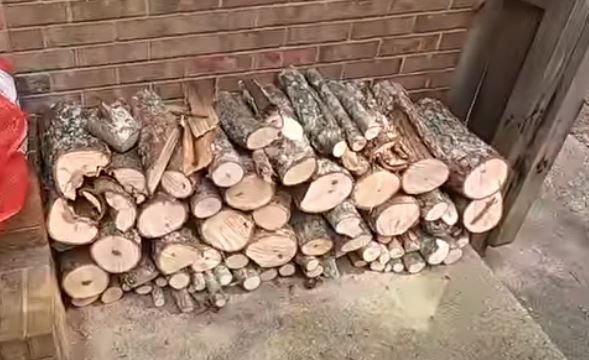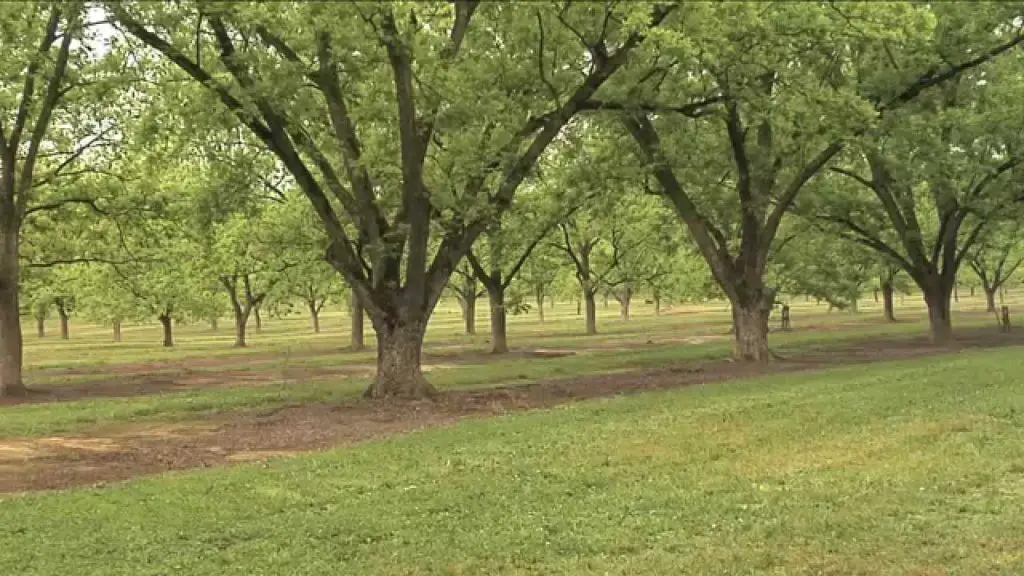Pecan makes excellent firewood due to its high heat production and pleasant smell but it can be difficult to split and takes up to 18 months to season.
Some say to use pecan wood as lumber, while others say to use it for smoking meats and BBQ, while many more say to use it as firewood.
Pecan lumber is very sought after and will create beautiful, shiny furniture that will last a lifetime. However, if the wood of your felled pecan tree is not in shape to be used as lumber, it is magnificent firewood. And don’t forget to save some of the wood for your next BBQ.
Table of Contents
Summary
- BTU: 28 million BTU per cord
- Weight: 4,500 lbs dry
- Seasoning Time: 12 to 18 months
- Splitting Difficulty: Medium to difficult
- Smoke: Low to Medium
- Smell: Pleasant and sweet
The pecan tree is a species of hickory, and there is the argument of which burns better. Pecan burns incredibly hot and burns nice and slow. It has a unique and pleasant smell and reasonably well-behaved firewood.
Pecan trees are primarily grown for their seed – or nuts. Pecan nuts are tasty, nutritious, and extremely popular, especially in the fall and winter.
Heat Production
Pecan has a high BTU, the same as hickory, 28 million per cord.
This high BTU means that pecan is ideal for use during the year’s coldest months.
Pecan is a hardwood that characteristically will have a higher heat production and burn for more extended periods of time.
Pecan firewood also creates great coals, which is ideal for wood stoves.

Smoke Production
While you should always use a screen or glass doors when burning inside, firewood that produces fewer sparks is safer. Wood that sparks heavily can create significant fire hazards.
Wood from pecan trees burns cleanly and has a low spark and crackle rate.
Seasoning Time
Seasoned wood has less than 20 percent moisture content. Firewood with a higher moisture content than 20 percent is harder to light and frustrating to burn. It also produces more smoke and creosotes buildup.
Pecan firewood will need anywhere from 12 to 18 months to properly season.
Unique to pecan wood, if you burn it before seasoning, the wood smell will be too overpowering to sit around the fire comfortably or to burn inside. It is imperative to season pecan wood, so it becomes pleasant to be around and burn.
This includes burning it for BBQ and smoking purposes. You’ll still want to wait 12 to 18 months before using your pecan wood in your smoker; otherwise, the taste of smokey pecan would overpower your meat.
Remember, seasoning time depends on where you live, what climate your wood is exposed to, and how you stack your wood. Wood will season quicker in dryer climates.
Burning Smell
As mentioned a few times already, pecan gives off a wonderful aroma when burned.
The pleasant smell may be pecan firewood’s most desirable characteristic.
The smell of pecan lingers long after the fire has been extinguished, which is an enjoyable bonus for those who enjoy the aroma.
When used for smoking purposes, it has a similar flavor to almond firewood which is mild and slightly sweet. It is not as bold as mesquite or hickory, both of which are smokier and pungent.
Creosote Buildup
Creosote is a dark brown tar deposited from wood smoke that can build up on the insides of your chimney walls. It contains tiny unburned particles of wood and sap found in smoke. Creosote can be extremely dangerous because of how flammable creosote is and will quickly start a chimney fire. Firewood with higher levels of sap will create more creosote.
A downside to Pecan firewood is that it has a surprisingly high moisture content of 25 – 50%. This is much more than other hardwoods.
That being said, Pecan firewood will season reasonably quickly and has very little sap to worry about.
Overall, creosote buildup from burning Pecan firewood is minimal and not something to worry about if you have correctly seasoned your wood.
Splitting
Splitting pecan firewood can range from relatively easy to extremely difficult but most often lands on the more difficult side of things.
Pecan wood tends to have many knots and twists, making splitting by axe quite tricky.
It is recommended to use a hydraulic or mechanical wood splitter to make your life easier when it comes to pecan.
Split the wood when it is as green as possible. The longer you let the wood sit, the tougher of a time you will have splitting it.
Split pecan wood into reasonably small pieces to help it dry out quicker. While pecan does season fairly quickly, smaller pieces will speed up the drying process.
Different Types/Species
Pecan trees are native to North America and are primarily grown for the production of pecan nuts. In 2013, 14 states reported pecan production, 3/4th of those were found in Georgia, New Mexico, and Texas.
Pecan trees grow wonderfully in orchards, and when given lots of space, they will grow wide. Limbs and branches from orchard trees often break off and can be easily used for firewood.
If you live in an area with pecan orchards, ask if you can have some of these broken limbs. You might be surprised that many will say yes!
Pecan trees thrive in warm, humid climates with access to lots of water and well-draining soil. Many pecan trees are disease resistant and easy to take care of.
Pecan nuts are found inside the fruit of the pecan tree. The fruit, also called the shell, can be pretty thin and easy to break, to extremely thick. Many will choose their pecan tree species based on the pecan fruit’s characteristics.
There are over 500 different varieties of pecan trees, but only a few are planted in the United States, being the most popular because of pecan nut production. All four of these trees are great for home gardens and do well in most mild to warm zones.

Hybrid American Chestnut Tree
The Hybrid American Chestnut Tree produces delicious nuts and is blight resistant. It can be grown in zones 5-9 in well-draining soil with full sun. They will attract deer.
Elliot Pecan Tree
Similar to the previous tree, the Elliot Pecan Tree is disease resistant and has a plentiful nut harvest. Many choose the Elliot Pecan tree because it has beautiful foliage. It can be grown in zones 6-9 and likes to be in full sun or partial shade.
Amling Pecan Tree
The Amling Pecan Tree is popular because it is very low maintenance and produces high-quality nuts. It is fast-growing and is resistant to pests. Zones 5-9 and full sunlight are ideal for the Amling Pecan tree.
Oconee Pecan Tree
Growin in zones 6-9 in full sunlight, the Oconee Pecan tree is known for its excellent yield potential. The Oconee Pecan tree will start producing nuts after its 5th year. Each year, the tree will produce higher quality and larger nuts. A fully mature Oconee Pecan tree has large, easy to crack, and delicious nuts.
Other Types of Pecan Trees
- Caddo Pecan Trees – native to Georgia, the Caddo Pecan tree is versatile and can take extreme heat and colder temperatures.
- Cape Fear Pecan Trees – native to North Carolina, this tree will produce many nuts even at a young age.
- Creek Pecan Trees – a very productive pecan tree that will continuously give more nuts each year.
- Desirable Pecan Trees – found in hot and humid climates, such as Florida, these trees are great for personal and commercial use.
- Mandan Pecan Trees – a northern pecan tree species that produces easy-to-shell nuts.
- Pawnee Pecan Trees – Pawnee Pecan trees are smaller than other types of pecan trees and are perfect for growing in the Deep South.
- Cheyenne Pecan Trees – made popular because they bear pecan nuts early in the season.
- Western Schley – found in the southwest, the Western Schley trees thrive in drier areas and high altitudes.
- Candy Pecan Trees – candy pecan trees are popular because their pecans are widely used for making candy treats.
- Kanza Pecan Trees – heat tolerant and disease resistant, the Kanza Pecan tree is perfect for hot and humid growing conditions.
- Kiowa Pecan Trees – found in the southeastern part of the US, this pecan tree requires a lot of water and produces an oblong pecan.
- Stuart Pecan Trees – popular in the southeast part of the US, the Stuart Pecan tree is hardy, large, and produces large nuts.
- Sumner Pecan Trees – they produce nuts after only 2-3 years and are excellent shade trees.
- Zinner Pecan Trees – low maintenance and great for beginner gardeners.
Comparison to Other Woods
Here are some of the most popular firewoods to burn indoors compared to Pecan firewood.
| Firewood | BTUs | Ease of Splitting | Coals | Overall Quality |
| Green Ash | 20.0 | Easy | Good | Excellent |
| Maple | 25.5 | Easy | Excellent | Excellent |
| Bur Oak | 26.2 | Easy | Good | Excellent |
| Pecan | 28 | Difficult | Great | Excellent |
Pecan firewood produces a significant amount of heat compared to other popular firewoods. It also makes nice coals and is overall an excellent firewood. The only negative to using pecan is that it can be tough to split and may have an overwhelming smokey smell if not fully seasoned.
Frequently Asked Questions
Can you burn pecan firewood in a firepit?
Yes, but some may say this is a waste of excellent firewood! Try, instead, to use your pecan wood as lumbar, smoking wood, or inside firewood first.
Is pecan firewood safe to burn in a fireplace or wood stove?
Yes, because correctly seasoned pecan firewood has low smoke production and very few sparks, it is safe to burn inside in a fireplace or wood stove.
How much does a cord of Pecan firewood cost?
A cord of green pecan firewood will cost around $150 if you are in an area where pecan wood is available. Seasoned pecan firewood and pecan mixed with other hardwoods will cost more.
Final Thoughts
Overall, it is evident that pecan firewood is among the top of the list because of its unique qualities and ability to heat the house well.
Pecan firewood is not available everywhere, however. If you live in a northern climate such as North Eastern US or Canada, pecan may be very difficult to find.
However, if you are lucky enough to live in an area with pecan trees, try to get your hands on some firewood! Ask your local orchard if you can take away some of their fallen branches or find some wild pecan trees nearby.
It has a beautiful smell and produces great coals, making it a favorite among wood stove and fireplace owners all winter long.
